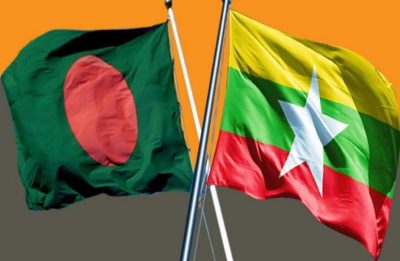Will China’s Belt and Road (BRI) Diplomacy Facilitate a Rapprochement Between Myanmar and Bangladesh?

China’s active diplomatic efforts in trying to resolve the “Rohingya” issue can facilitate a rapprochement between Myanmar and Bangladesh that strengthens their trilateral cooperation through the Belt & Road Initiative (BRI) and secures a second corridor for Beijing to the Afro-Asian (“Indian”) Ocean complementing the one that it’s already pioneered through the global pivot state of Pakistan via CPEC.
Xinhua reported earlier this week that China, Myanmar, and Bangladesh held their third informal Foreign Minister meeting since last year on the sidelines of the UN General Assembly and agreed to three points of consensus on the “Rohingya” issue that’s plagued bilateral relations between Beijing’s two Belt & Road Initiative (BRI) partners for the past two years already. The outlet described the outcome of their talks as resulting in “the strong political will and important political consensus of the three parties to realize the repatriation as soon as possible”; “unanimously agree[ing] to establish a China-Myanmar-Bangladesh Joint Working Group mechanism…to be responsible for the concrete implementation of repatriation-related work”; and that “development is the fundamental way to solve the Rakhine issue”. Interestingly, this is exactly what the author proposed in his September 2017 analysis about “The Rohingya Crisis: Conflict Scenarios And Reconciliation Proposals“.
China’s interest in the “Rohingya” issue stems from the lasting impact that it could have on the stability of Myanmar and Bangladesh if it’s not responsibly resolved, which could in turn jeopardize its investments in both of them and especially the viability of its planned China-Myanmar Economic Corridor (CMEC) that will run parallel to its existing pipelines through the country to connect the Yunnan capital of Kunming with the port of Kyaukphyu. This corridor to the Afro-Asian (“Indian”) Ocean is expected to complement the existing one that China already pioneered through the global pivot state of Pakistan via BRI’s flagship project of CPEC and thus ensure the reliability of the Silk Road across the Eastern Hemisphere’s centrally positioned body of water by avoiding the increasingly militarized South China Sea and the US Navy-controlled choke point of the Strait of Malacca. As regards China’s interests in Bangladesh’s stability, the South Asian state is one of its closest regional partners and has already been the recipient of approximately $38 billion worth of investments.
China originally envisaged directly connecting the Silk Road through both of those countries and India through the Bangladesh-China-India-Myanmar (BCIM) Corridor, but New Delhi stonewalled the initiative following its grand strategic reorientation away from Eurasia and towards the US’ “Indo-Pacific” policy of “containing” China in recent years and therefore made this project all but impossible. That said, China is relentless in its desire to see the Silk Roads succeed, hence why it’s modified its relevant strategy to functionally exclude India and unofficially create a BCM Corridor instead that would connect the People’s Republic with Bangladesh through CMEC and then onward across the Bay of Bengal to the South Asian state. For that plan to succeed, however, relations between Myanmar and Bangladesh must first normalize, which can’t happen without resolving the “Rohingya” issue. Both countries have been unable to do so on their own owing to their zero-sum stances towards this crisis, hence why they sought out China’s diplomatic services in facilitating a solution.
Seeing as how they’re all connected through the Chinese-led BRI, it can be said that Beijing is therefore practicing BRI-plomacy (a portmanteau of BRI and diplomacy) because its end goal directly relates to actualizing this global initiative’s regional plans for the BCM Corridor. In pursuit of this, China might even begin experimenting with what the author previously called BRI-Aid, which would be that country’s form of USAID that contributes to social development in underdeveloped areas like Myanmar’s northern Rakhine State where the “Rohingyas” fled from but doesn’t lead to covert interference in the recipient’s domestic affairs like its American counterpart does. This isn’t mere speculation on the author’s part either, but a between-the-lines reading of the third point agreed to by all three countries’ Foreign Ministers this week about how “development is the fundamental way to solve the Rakhine issue”. Standard BRI investments can only go so far in a conflict-ravaged region, which is why it might be necessary to expand their scope to include humanitarian aid too.
What makes China’s BRI-plomacy with Myanmar and Bangladesh so interesting is that it’s literally unprecedented since Beijing had thus few refrained from politically involving itself in its partners’ domestic problems and bilateral disputes with their neighbors, but was called upon by both in this instance to act as a neutral mediator given the deeply trusting relations that it’s formed with each of them and their collective interests in intensifying their connectivity through BRI. China was already engaged in “military diplomacy” with both of them along the lines of the Russian model by selling large amounts of arms to these neighboring states in order to retain the balance of power between both of them and thus facilitate a political resolution to their problems, so it’s sensible that it would expand these indirect outreach efforts to something more directly relevant to their current challenges through its ongoing BRI-plomacy over the “Rohingya” issue. If successful, then this approach could possibly be applied towards solving problems with other BRI countries elsewhere, too.
Originally published on One World.
Andrew Korybko is an American Moscow-based political analyst specializing in the relationship between the US strategy in Afro-Eurasia, China’s One Belt One Road global vision of New Silk Road connectivity, and Hybrid Warfare. He is a frequent contributor to Global Research.

